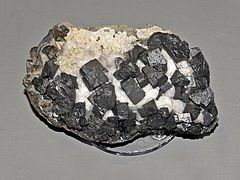Ullmannite
| Ullmannite | |
|---|---|
 |
|
| General | |
| Category | Sulfide mineral |
|
Formula (repeating unit) |
NiSbS |
| Strunz classification | 2.EB.25 |
| Crystal system | Cubic |
| Crystal class | Tetartoidal (23) H-M symbol: (23) |
| Space group | P213 |
| Unit cell | a = 5.91(2) Å; Z = 4 |
| Identification | |
| Color | Steel-gray to tin white |
| Twinning | Penetration twins about [110] |
| Cleavage | Perfect on {001} |
| Fracture | Uneven |
| Tenacity | Brittle |
| Mohs scale hardness | 5-5.5 |
| Luster | metallic |
| Diaphaneity | Opaque |
| Specific gravity | 6.65 - 6.85 |
| References | |
Ullmannite is a nickel antimony sulfide mineral with formula: NiSbS. Considerable substitution occurs with cobalt and iron in the nickel site along with bismuth and arsenic in the antimony site. A solid solution series exists with the high cobalt willyamite.
Ullmannite is steel-gray to tin white in color with a metallic luster, has a Mohs hardness of 5 to 5.5 and a specific gravity of 6.65. Initially thought to be of two species, tetrahedral and cubic, it was later confirmed that both samples conformed to the 23 point group of the isometric crystal class and typically exhibits cubic, octahedral, or pyritohedral forms although euhedral crystals are rare.
Variance in its chemical composition has been shown to be responsible for loss of symmetry and variations in striation patterns.
Ullmannite crystals are usually less than 2 mm, however larger have been identified in especially antimony rich environments. Ullmannite commonly displays interpenetration twins as well as enantiomorphic twinning along [110].
It is a member of the cobaltite group and forms a series with willyamite ((Co,Ni)SbS). It occurs with nickeline, gersdorffite, pentlandite, chalcopyrite, pyrrhotite, galena, tetrahedrite and dyscrasite in hydrothermal deposits.
Principal localities are in Germany, it is also found in Austria, Australia, France, England, and Wales.
...
Wikipedia
